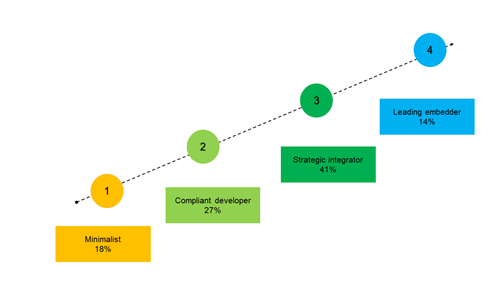
Navigating sustainability transformation risk
Assessing your organisation’s maturity for success

Every organisation that chooses to embrace sustainability will need to consider the impact on its overall operating model at some stage. This includes understanding and embedding sustainability into all aspects of their operating model to maximise the return on their investment in sustainability. In this article, we build on the transformation insights from our Sustainability Survey, and explore the maturity of the sector, and how well insurers and reinsurers are embedding sustainability in their organisations.
2024 remains pivotal for many organisations as they continue to integrate and embed sustainability into core business activities, such as underwriting and new product development. The six steps for creating a successful sustainability operating model article outlines the link between sustainability, purpose, and profit. Many insurers are still grappling with establishing this link, and the Sustainability Survey provides insight on the progress being made.

Figure 1. Respondents by sector
- The survey captured views from sustainability and climate risk teams and had a 45% response rate.
- 56% of respondents were from the general insurance sector and 15% were reinsurers.
- Organisation size was split evenly between large organisations with over 1000 employees and smaller companies.
- 62% of organisations were based in the United Kingdom, 22% in Bermuda and the remainder in Continental Europe.
Sustainability journey: From consideration to integration
Many organisations are embarking on the sustainability journey. Majority have focused primarily on compliance and reporting and very few organisations can say they have fully embedded sustainability within their operations.
Four maturity profiles emerge across all sectors:
- The minimalist – The minimalists are still at the starting blocks. They understand the general purpose of sustainability but are unlikely to have considered what it means for their organisation or made any real commitment beyond initial statements of intent and minimum compliance.
- The compliant developer – Compliant developers have moved beyond intent and have begun establishing structures. They have also begun to consider and implement initiatives in parts of the organisation to enable effective compliance and delivery on their commitments.
- The strategic integrator – Strategic integrators have set a clear ambition and have a clearer line of sight to their strategy. They have begun to raise the profile of their work with their closest stakeholders and sustainability is a key consideration on decision making.
- The leading embedder – Sustainability and resilience considerations drive the strategy.
They have fully established structures and have a clear golden thread from their mission and vision through to measures and incentives. They are committed to and have contributed to the development of standards, have begun embedding sustainability across their organisation, and started exploring opportunities to be more innovative and efficient.

Figure 2. Current maturity profile across all respondents
Organisations are at varying stages of maturity and there is a lot more to do to embed sustainability considerations into operational and strategic decisions. Life and Pensions insurers are more likely to have amended their investment models and the asset side but have made less advancement on their supply chains. The opposite is often seen to be true for General Insurers and Reinsurers.
18% of survey respondents have begun to embed sustainability, and another 27% working on improving compliance (see Figure 2).
Organisations that take a reactive and compliance driven approach to sustainability, will typically struggle to achieve the traction and commitment required to truly become a leader in this space.
How mature do you want to be?
Do you have a clear view of your current maturity baseline, and have you decided how mature you want to be and over what period? Some organisations have not made a conscious decision to answer this question. This can result in lack of clarity and direction, unfocused efforts, and a risk that they will not realise any return on their investments.
As you look to the future and set ambitions for 2024 and beyond, it is essential to establish a clear baseline and target. This can be done by assessing the maturity of your organisation and your sustainability journey using a reference maturity framework. You can design and roll out an assessment yourself, have one tailored specifically to your organisation, or use one that is off the shelf.
The Crowe Sustainability Maturity Profile (Figure 3) assesses where firms are across six key change dimensions and provides a starting point for Board and Executive conversations. It can be used just as is or tailored to your organisation needs.
Figure 3: Crowe Sustainability Maturity Profile
Do you have a clear view of your current maturity baseline, and have you decided how mature you want to be and over what period? As you plan and set ambitions for 2024 and beyond, it is essential to establish a clear baseline and target.
Our sustainability transformation services include:
- compliance gap analysis
- operating model maturity assessment
- culture and change interventions
- training and education across all levels of your organisation
- organisation design based on your sustainability strategy and ambition
- strategic alignment of climate risk and sustainability factors into strategy, operational, technology, procurement, people, and cultural practices
- delivery of embedded sustainability initiatives.
For more information, please contact Buki Obayiuwana or Alex Hindson, or click here to view our related services.
Insights
Contact us




